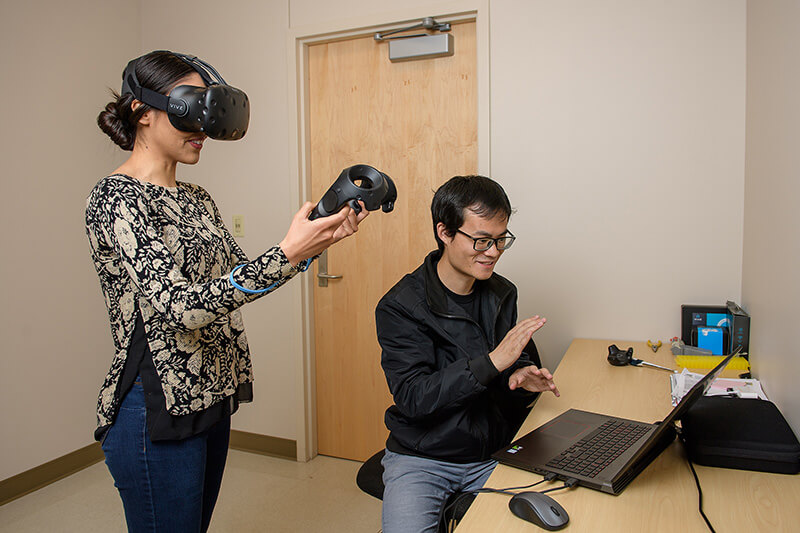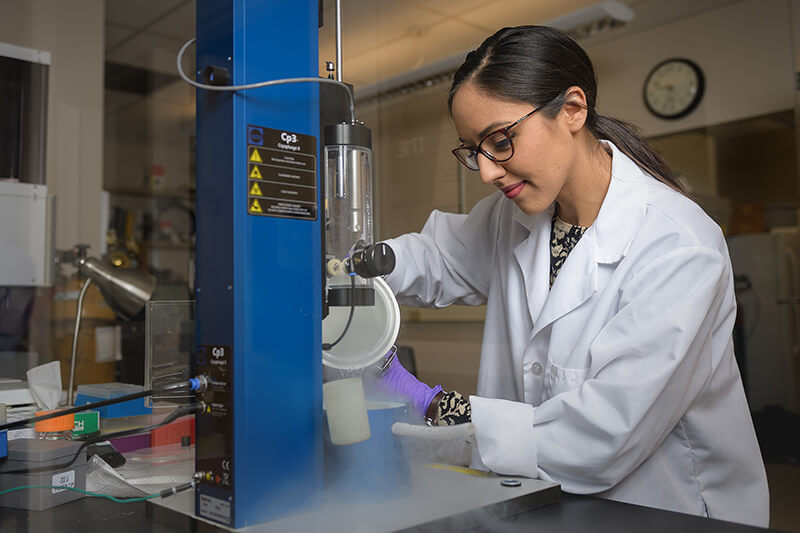May 15, 2018
Purdue team receives NIH grant to create virtual reality training solutions for cryo-EM

Purdue master’s student Jun Zhang, seated, and doctoral student Brenda Gonzalez demonstrate the CryoVR. The virtual reality training platform received a grant from the National Institutes of Health. (Purdue University photo/Rebecca Wilcox)
WEST LAFAYETTE, Ind. — A multidisciplinary project is bringing three professors from multiple Purdue colleges together for research improving training and potential interest in the scientific field of cryo-electron microscopy (cryo-EM).
The National Institutes of Health today (May 15) announced a three-year grant totaling $367,347 for the work of Yingjie “Victor” Chen, a professor of computer graphics technology in the Purdue Polytechnic Institute; Wen Jiang, a professor in biology from the College of Science; and Bill Watson, an associate professor in learning design and technology from the College of Education.
To help manage the project, the trio is joined by Thomas Sors, assistant director of the Purdue Institute of Inflammation, Immunology and Infectious Disease.
The team is developing a virtual reality system CryoVR that allows people to learn the intricacies of delicate and not readily available laboratory instruments, such as a cryo-electron microscope, which carries a multimillion dollar price tag.
Training new users of cryo-EM “is like teaching a novice driver how to drive, but in a very expensive Formula 1 race car,” Sors said. “Mistakes can be very expensive and there is little room for error.”
According to the team, demand for existing training opportunities exceeds capacity and its expected this demand will rise as adoption of cryo-EM technology continues to increase.
 Brenda Gonzalez, a doctoral student in the CryoVR project, works with a plunger to prepare sample grids for cryo-EM imaging. The CryoVR project will help train people for using multimillion-dollar laboratory instruments. (Purdue University photo/Rebecca Wilcox)
Download image
Brenda Gonzalez, a doctoral student in the CryoVR project, works with a plunger to prepare sample grids for cryo-EM imaging. The CryoVR project will help train people for using multimillion-dollar laboratory instruments. (Purdue University photo/Rebecca Wilcox)
Download image
“It’s been extremely exciting research in recent years, but the learning curve is very steep,” said Jiang, director of the Purdue Cryo-EM Facility. “Right now, we recognize the current training approach is very limited. It’s not efficient, it’s not high quality.
“We’re looking at this from the education aspect on how to improve the training efficiency.”
The grant is part of the NIH program for Cryo-EM Curriculum Development. The funds will support creative educational activities with a primary focus on curriculum or methods development in cryo-EM for structural biology research.
“This is really about tactile learning, the hands-on training opportunity,” Chen said of the project, adding the VR program lends itself to trainee’s muscle memory by allowing the person to handle the machine repeatedly.
Floating hands on a laptop screen show the VR user putting their sample on a virtual a cryo-electron microscope for preparation of cryo-EM grids and reaching for a lineup of tools to the right. The sample placement and the tools react as the user interacts with each while, in the background, a video shows the user the proper technique.
“We’re trying to just give the user a personal experience in the environment,” Chen said. The team also is working on creating new VR tools that simulate other cryo-EM instruments and sequence of operations.
Purdue’s Cryo-EM facility has been part of the field’s recent momentum, as it was used by a team led by Purdue researchers in determining the structure of the Zika virus in 2016.
Putting together the VR program, however, is more than just graphics on a computer screen. Making sure the system is adaptable to users is where Watson joins the work.
“When we look at how learners learn today, by and large, they learn with interactive technology that gives them clear and consistent feedback so that they can learn by failing,” Watson said. “People today come with the approach of don’t give me a 300-page manual, let me get in there and try it out. And that’s great until you’re talking about multimillion-dollar machines.”
Watson said the VR program gives users a safe space to learn that they normally wouldn’t have access to while also giving them a key place to fail in the process.
Previous training modules supported by the NIH are excellent and include video trainers, Sors said, adding the intent of the Purdue project is to incorporate those into the CryoVR environment. The inexpensive nature of VR goggles today will allow more people to take advantage of the training platform.
He said the Purdue Institute of Inflammation, Immunology and Infectious Disease helped link this team together and is interested in continuing to foster the professors’ collaborative work, noting Purdue is the only university with cryo-EM facility in Indiana.
“This is a strong area of interest for several members of our institute and we want to continue to deepen our excellence in this area,” he said. “Anything we can do to help with the training and help people gain more access to the technology is a goal.”
Writer: Brian L. Huchel, 765-494-2084, bhuchel@purdue.edu
Sources: Thomas Sors, 765-494-1678, sors@purdue.edu
Yingjie Chen, 765-494-1454, victorchen@purdue.edu
Wen Jiang, 765-496-8436, jiang12@purdue.edu
Bill Watson, 765-494-9735, brwatson@purdue.edu
Note to Journalists: The NIH grant award to the CryoVR work is 1R25EY029127-01.

